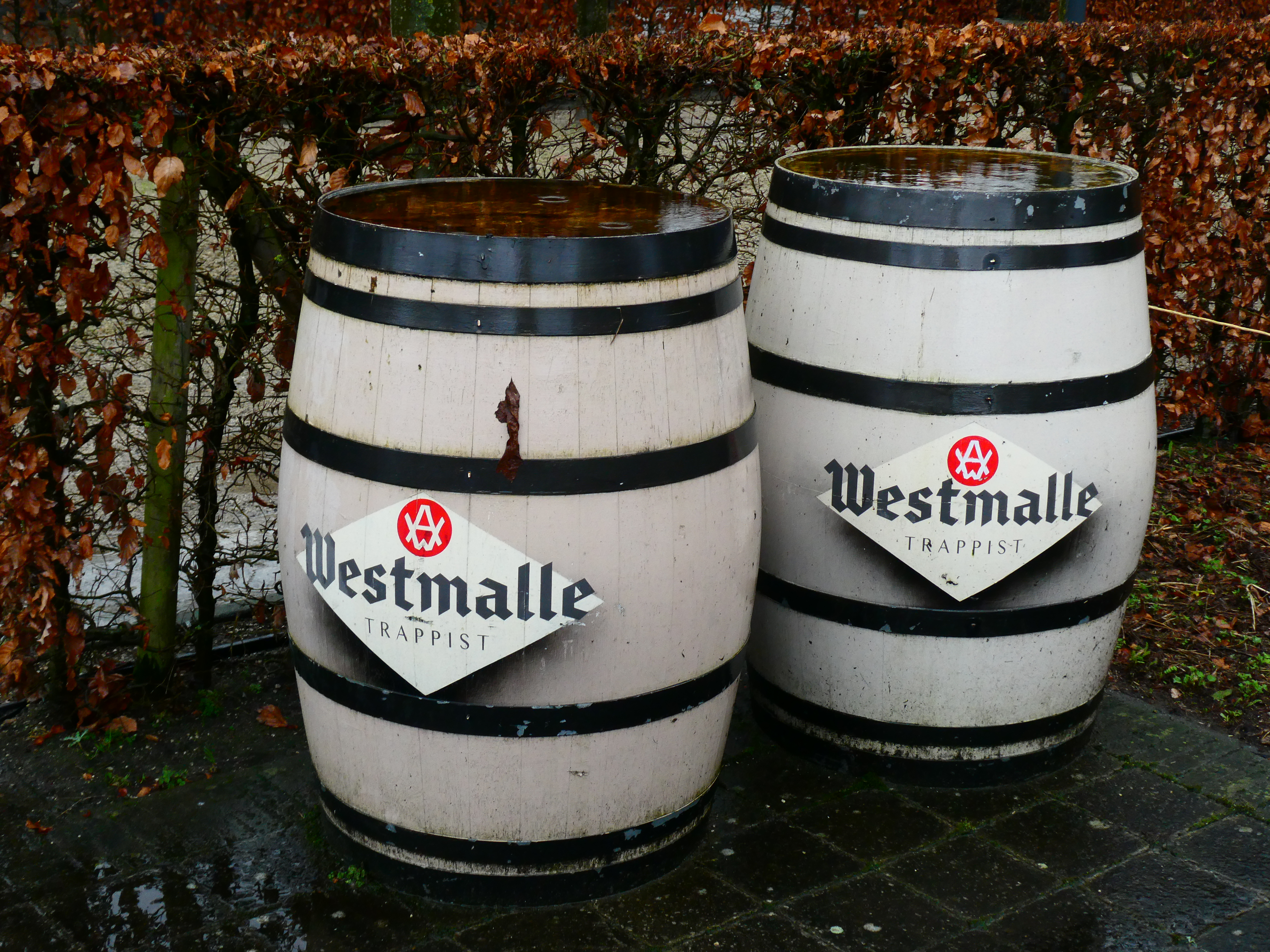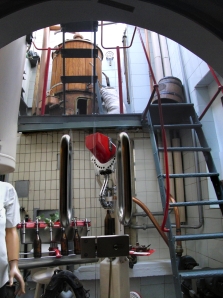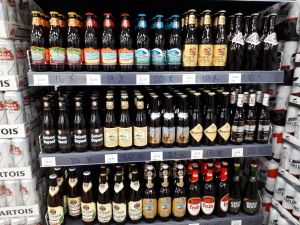New beer and old trams 24 February 2016
Posted by cooperatoby in beer, Brussels, tram.Tags: beer, Brussels, trams
add a comment
I’m delighted to have discovered, albeit 7 months after its opening, Brussels’s 3rd brewery . The first is the venerable Cantillon and the second is my staple Senne, which is currently brewed on the wrong side of the tracks in the not-to-be-dreaded Molenbeek) but, being faced with 30% annual growth, is soon to move to Tour & Taxis. En Stoemlings is just round the corner from the renovated art nouveau Palais du Vin with its restaurant, conference centre, small business incubators (one of whose tenants uses the brewery’s spent grain to grow mushrooms) and excellent biomarché. What complementarity! It’s making the Rue des Tanneurs a very hip place to be.
En Stoemelings – a Brussels phrase meaning ‘on the sly’ – brews a 7% triple called Curieuse Neus which I will report back on when I’ve had the chance to extract it from its 75cl bottle. They say it is well balanced as they are leaving very hoppy beers (the IPA craze) to Senne, and recommend it be drunk cold, which I hesitate to do but will experiment with. What’s more, the beer-and-trams nexus heaves back into view with the forthcoming launch of draught lemon-flavoured Geele Tram (in memory of the town’s old tram livery) at Moeder Lambic in Place Fontainas.
Brasserie Stoemelings
Rue du Miroir 1, 1000 Bruxelles
https://www.facebook.com/enstoemelings
Late news: Yet another beer-tram-wholefood triad – the Beerdays on 14-15 May 2016 at the Ecuries van de Tram in Schaerbeek.
Guerrilla marketing 3 November 2013
Posted by cooperatoby in Amsterdam, beer.Tags: art, beer, museum, NL
add a comment
Last night saw my third stint as guest barman at Castrum Peregrini, an arts-based ‘intellectual playground’ in Amsterdam’s city centre, during Museumnacht, when the cream of Amsterdam’s museums stay open till 2 a.m. During World War II, Castrum was a hiding place for German refugee artists, and in 2011 won the prize for the best exhibit (Truus is on its programme advisory group). This year, the show featured the Atelier Revolutionair, which explored the role artists are playing in struggling for justice, diversity and social inclusion worldwide. There was an exhibition called Speaking from the Heart curated by Shaheen Merali – and an Iranian disco.
 In a throwback to my Ale House days, I made it my mission to subvert the tenacious and irrational belief among Dutch people that Heineken is a good beer by wearing my IJbrouwerij t-shirt. This subtle bit of guerrilla marketing resulted in at least one customer’s hopes being raised that something decent to drink would be on offer – but they were cruelly dashed. I could tell he was a man of principle as he preferred to drink nothing rather than Heineken.
In a throwback to my Ale House days, I made it my mission to subvert the tenacious and irrational belief among Dutch people that Heineken is a good beer by wearing my IJbrouwerij t-shirt. This subtle bit of guerrilla marketing resulted in at least one customer’s hopes being raised that something decent to drink would be on offer – but they were cruelly dashed. I could tell he was a man of principle as he preferred to drink nothing rather than Heineken.
We looked enviously across the Herengracht at the trip boats disgorging into a permanent queue outside NIOD, the National Institute for War Documentation, whose first foray into Museumnacht it was. Nevertheless we did a decent turnover purveying not only wine, ‘beer’, tea and coffee, but also delicious home-made pumpkin soup – served straight out of a picturesque giant pumpkin (shame I didn’t have my camera with me) – and that unwieldy Dutch staple, the rookworst. There’s nothing like a rookworst to pick you up after an exhausting night of museum-going.
I’m hoping and praying that when Museumnacht comes round next year, Castrum Peregrini will become a unique haven of hoppy tasty ale.
Belgian Beer World – stock ale 20 June 2013
Posted by cooperatoby in beer, Brussels.Tags: beer, Brussels, museum
3 comments
Great news that Brussels’ disused stock exchange is to be turned into the Belgian Beer Temple (now renamed Belgian Beer World – see update below). It’s good that we should worship beer there and not capitalism. I particularly like the idea that the exploration of Belgium’s brewing heritage will be “a non-linear discovery, with a dynamic and interactive content” according to Brussel Nieuws. Belgian beer is certainly strong enough to make it so!
The city and the brewers’ federation have the ambition to turn this landmark, which is appropriately modelled on a Greek temple and whose front steps are a favourite perch for young people, into one of the city’s top five tourist attractions. I suspect it has something to do with the plans to pedestrianise the square in front of the building. It’s about time: I remember being distinctly underwhelmed by my visit to the dingy Brewers’ Guildhall on the Grand’ Place many years ago, so somewhere with more natural light and space will be welcome. The brewers’ federation has already been testing the water with its annual Beer Weekend in that same square and it has proved very popular (even if deterringly bureaucratic).
Two ways to fail
There are two ways the brewers could mess this idea up. First they could over-commercialise it – a warning may be found in the horrific prices charged at the shop called the Beer Tempel in Grasmarkt. (Does the brewers’ federation already run that? I never guessed.)
The second would be to exclude the smaller and more innovative brewers that are springing up. For years the only brewer actually brewing beer for sale in the city was aeons-old gueuze paradise Cantillon. It was joined in 2010 by the Brasserie de la Senne, who dared to brew stout and use an English amount of hops in their beer. This month sees the Brussels Beer Project market testing 4 beers called Alpha, Beta, Gamma and, you guessed it, Delta. It aims to be a ‘community brewery’ – not only do the public get to vote on how the beer should taste, they will also be asked to crowdfund it. This is the sort of new and experimental brewing that will keep beerophiles coming back.
Update 2020
Work to renovate the stock exchange finally got under way in February 2020, and the museum is scheduled to open in 2023, a decade after I wrote the above. It will feature some 100 brewers, so my chief concern has been met. It looks like being a fun sort of place, with a public rooftop restaurant and an underground link to the archaeological ruins abutting it. Well done to the public-private partnership managing it.
Triple point 17 November 2012
Posted by cooperatoby in beer, cooperative, Leeds, tram.Tags: beer, co-op, Leeds, trams
2 comments
It’s always amusing when two obsessions collide unexpectedly – it gives that frisson of the interconnectedness of all things – and even better when three do. I had that enjoyable thrill upon learning that there is a bar in Wilmersdorf, Berlin called Die Straßenbahn (The Tram) and that it bills itself as Berlin’s oldest collective. As trams are a collective means of transport, and beer is best enjoyed in a group, I suppose it’s not so strange.
Die Straßenbahn was founded in 1977, which puts it slightly ahead of the Ale House in Leeds, which was founded in 1979 and opened its doors in 1980. Our take on worker collectives was the common ownership worker’s co-operative, which put a legal form around the loose operating principles of collectivism: non-discrimination, equal pay, job rotation, collective decision-making. In creating this model constitution, ICOM, provided a quick and easy way for radical groups to establish businesses that would express their political values. It managed to bridge the gap between company law (IPS law actually) and the arduous processes of collective decision-making, which at their best are intuitive and rewarding, and at their worst require endless discussion until all opposition is persuaded, crushed or bored into acquiescence, without even the dignity of recording a vote against.
The beer revolution
In our case, we diversified into a wholesale operation and eventually a microbrewery, but the co-operative eventually collapsed and the shop was taken over by Timothy Taylor’s – which is a noble enough end for any real ale business. The collective in Berlin have carried on living that dream, complete with equal pay, fortnightly team meetings and a tips pot which goes to good causes – I very much hope to go and drink a pint or two there soon. And the same ideal is coming true across England as more and more village pubs are rescued by community co-operatives making use of the community shares principle.
PS (thanks Hans-Gerd) and not only in the UK:

The joy of organs 5 March 2011
Posted by cooperatoby in beer.Tags: beer, museum, NL
add a comment
I’ve discovered a new joy in organs – of the street, café or dance variety.
It all started when my cousin Steve Greatrex took me to the Museum Speelklok in Utrecht. This not only collects and restores mechanical musical instruments and curious automata of all sorts, but is a paradise for children, who can punch out and play their own tunes. Last week was half-term so it was busy: the museum now attracts over 110,000 visitors a year. One of the main reasons for its success must be the enthusiasm of the guides, who are mostly music students. It’s absolutely infectious. And it’s a popular art from, the predecessor of the jukebox and the MP3 player.
As we were shown round by Jelle Verhoeks and Alberic Godderis, I had a sudden flashback. I remembered how once day in the late 80s I’d set out on a beer expedition to Beersel, a village southwest of Brussels. We tracked down the Oud Beersel pub on the outskirts, which had a reputation for its home-blended gueuze. We installed ourselves in the middle of the room, at a party table encircled by a round bench. As we supped our sour beer, the landlord walked over to a contraption built into the wall, opened it up, pressed a button and played us a rousing tune. I didn’t know what to make of it at the time, but now I realise I was privileged to be listening to what was probably Belgium’s last café organ, a Mortier Orchestrion (NB not so, there is the Café Beveren in Antwerp). The pub was turned into a flower shop for several years and the organ was sold to an American collector. Happily the brewery nextdoor was reopened in 2006, and the pub – the Bierhuis Oud Beersel – in 2021.
Until quite recently an organ grinder toured the back streets of St-Gilles a couple of times a year, but nowadays it’s quite rare to find an organ, a Dutch trademark, on Holland’s streets. There are plenty of collectors so they are no longer being broken up. But it’s a real shame that such uplifting and essentially public instruments should be hidden away in private and never heard.
Holland in miniature 17 October 2009
Posted by cooperatoby in beer, tram.Tags: beer, museum, NL, trams
add a comment
A fortnight ago, in perfect autumn weather, we visited the Nederlands Openluchtmuseum near Arnhem. it has everything: a tramline to get around on, a brewery and even its complement, a street urinal.
Of course it covers all the Dutch stereotypes: it is dotted with windmills of various types, and has a steam-driven dairy where they will sell you various sorts of gouda. It has a reconstituted pond out of the Zaanstreek (strangely out of place up there in the Veluwe), with a green weatherboard house from Marken and a white drawbridge and a hand-hauled rope-guided ferry. You can shop in the bakery and the cavernous sweetshop, and sit and eat poffertjes or try riding a penny-farthing.There’s an appelstroop manufactory, a piggy-bank collection, an Indonesian house, a maze…
The whole thing strikes exactly the right balance between its high-minded educational mission, national nostalgia and commerce. You can even get there by trolleybus. It makes a perfect day out.
Raven Mad – pub co-op owes its birth to TV 8 October 2009
Posted by cooperatoby in beer, cooperative.Tags: beer, co-op
add a comment
Amazing to see the media industry creating the “reality” it is more conventionally supposed to report on – but this time with a result we can approve of. In February this year, production company TwoFour announced that it would like to film a series about a community saving its own pub. “Twofour will work with the current owners to encourage the local community to muck in and run the pub for one month, with support from our expert landlord and presenter, Jay Smith, who owns a number of successful bars in the north of England. Everyone involved will be trained in all the necessary skills to run their pub,” it said.
And hey presto by September, the inhabitants of Llanarmon-yn-Ial, near Mold, Denbighshire, had bought the Raven and formed a co-operative guarantee company – Raven Mad – to run it.
A TwoFour spokesman quoted in the pub trade newspaper The Morning Advertiser, said: “With so many rural pubs closing around the country, Twofour is delighted to have the opportunity to help save some of them. The precedent of community run pubs has proved successful, and hopefully this show will encourage more to go down this route. We wish The Raven every success.”
After standing empty for three months, the historic pub was auctioned in July, but no one would bid the £250,000 guide price. However Raven Mad has now secured a six-year lease. The pub reopened on 30th August.
Co-operative spokesman Doug Macpherson recognised the encouragement the TV company had given: “The village is one of few remaining with a shop, post office, school and pub. Villagers were very saddened to see the pub close but, like many other communities, felt powerless to do anything about it. The offer from the television company has enabled the community to come together with the support of an experienced mentor to re-open the pub.”











